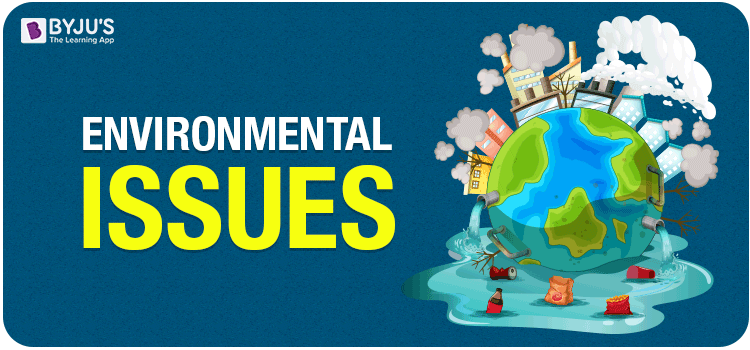Table of Contents
- Environmental Issues
- Climate Change
- Global Warming
- Ozone Layer Depletion
- Water Pollution
- Air Pollution
- Solid Waste Management
- Deforestation
- Overpopulation
- Solutions to Environmental Issues
An environment is generally defined as the surroundings or conditions in which a person, animal or plant survives or operates. From this, it must be relatively easy for one to comprehend its importance in the famed cycle of life.

Our environment is constantly changing, and as our environment changes so does the need to become increasingly aware of the environmental issues that are causing these changes. With a massive increase in natural disasters, warming and cooling periods, and different types of weather patterns, people need to be a lot more cautious with the way they lead their lives in conjunction with the types of environmental issues our planet is facing.
Also Read: Our Environment

Environmental Issues
Environmental issues are the harmful effects of human activities on the environment. These include pollution, overpopulation, waste disposal, climate change, global warming, the greenhouse effect, etc.
Various environment protection programs are being practised at the individual, organizational and government levels with the aim of establishing a balance between man and the environment.
Some of the current environmental issues that require urgent attention are:
Climate Change
Climate change is a great concern in today’s scenario. This problem has surfaced in the last few decades. Greenhouse gases are the major cause of climate change. Environmental changes have several destructive impacts such as the melting of glaciers, change in seasons, epidemics, etc.
Global Warming
The burning of fossil fuels, emissions from automobiles and chlorofluorocarbons add to the greenhouse gases in the atmosphere. This has led to an increase in the earth’s temperature causing environmental changes. This increase in temperature across the globe is known as global warming.
Ozone Layer Depletion
The ozone layer is a layer of concentrated ozone gas. It protects us from the sun’s harmful ultraviolet rays. This very important layer is being destroyed by CFCs (chlorofluorocarbons), which are used in industries and everyday life (e.g. aerosol cans).
The chlorine in these compounds destroys the ozone layer. The hole in the ozone layer leaves humans and wildlife exposed to harmful UV rays resulting in several skin diseases including cancer.
Water Pollution
The introduction of harmful substances into rivers, oceans, lakes and ponds, which changes the physical, chemical or biological condition of the water is called water pollution. The polluted water lacks oxygen and therefore the organisms die.
Water is the main source of life and therefore it is our prime duty to prevent it from any kind of pollution.
Air Pollution
Air pollution is the result of emissions from industries, automobiles, and the increasing use of fossil fuels. The gaseous emissions have added to an increase in the temperature of the earth. Not only this, but it had also increased the risk of diseases among individuals.
Solid Waste Management
Solid-waste management is defined as the discipline associated with the generation, storage, collection, transfer and transport, processing, and disposal of solid waste in a manner that it does not have a harmful effect on the environment.
Deforestation
Deforestation is the depletion of trees and forests at an alarming rate. The trees provide us with oxygen, and several raw materials and also maintain the temperature of the earth. Due to the depletion of trees for commercial purposes, there has been a drastic change in the earth’s climate.
Forests are an abode to a large number of wild animals and plants. Destruction of forests has led to the elimination of a large number of plants and animal species affecting biodiversity.
Overpopulation
The earth’s population is increasing drastically. It is estimated to be more than seven billion. The increasing population has led to a shortage of resources. If this continues, it will be very difficult to sustain such a huge population. The other environmental issues including pollution, waste management, deforestation, climate change and global warming are all associated with overpopulation.
Also Read: Solid Waste Management
Solutions to Environmental Issues
Following are some of the most common solutions to the environmental issue:
- Replace disposal items with reusable items.
- The use of paper should be avoided.
- Conserve water and electricity.
- Support environmental friendly practices.
- Recycle waste to conserve natural resources.
Environmental issues are a warning of the upcoming disaster. If these issues are not controlled, there will soon be no life on earth.
Also Read: Water Pollution and its Control
For more information on Environmental Issues and their solutions, keep visiting BYJU’S website or download BYJU’S app for further reference.

Frequently Asked Questions
Define pollution.
Define pollutants.
If our atmosphere air gets polluted by mixing with smoke or any harmful gases which are injurious to our health then it is a type of pollution and unwanted gases or smoke is a pollutant.
Name two diseases caused by air pollution, water pollution and noise pollution.
Diseases caused due to air pollution, water pollution and noise pollution are following:
- Air Pollution: Asthma and lung cancer
- Water Pollution: Diarrhea and cholera
- Noise Pollution: Hearing problems and Hypertension
Define the ozone layer. Why is the ozone layer getting depleted at a higher level of the atmosphere?
Due to the release of CFCs in the environment, the ozone layer is getting depleted at higher levels of the atmosphere.


Nice
But I want people invite locality aware of can change taking place in the local environment due to climate change and the impacts of the people in my village \ town this topic project so please help me I am your student
This was very helpful for me
Thank you byjus app for helping me
I like this
Ty it is very useful
It is really very helpful to us ✨
Wow a great piece of information you are provide.
It is really very helpful to us thank you byjus app for helping me